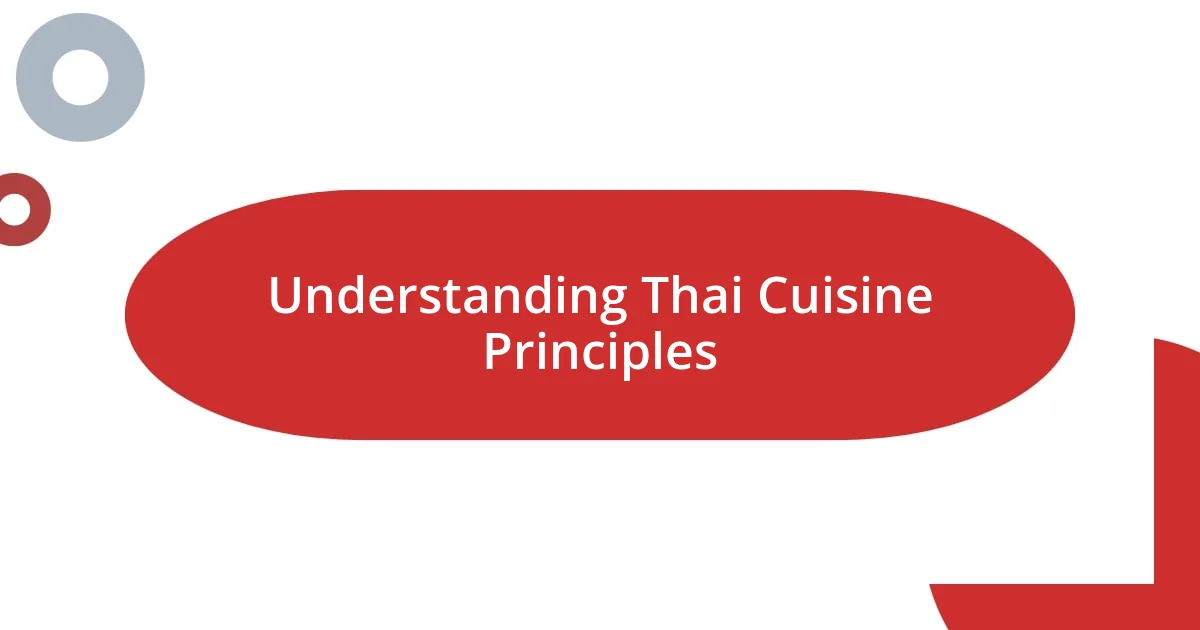Key takeaways:
- Thai cuisine centers on balancing five fundamental flavors: sour, sweet, salty, bitter, and umami, heightened by the use of fresh ingredients and intricate presentation.
- Essential ingredients like fish sauce, Thai basil, and coconut milk are crucial for achieving authentic Thai flavors, with each ingredient contributing uniquely to the dish.
- Engaging guests through interactive experiences, storytelling, and creating a welcoming ambiance enhances the culinary event, while post-event evaluation helps improve future gatherings.

Understanding Thai Cuisine Principles
Thai cuisine is built on the harmony of five fundamental flavors: sour, sweet, salty, bitter, and umami. This balance creates dishes that are vibrant and complex, inviting diners to experience a symphony of tastes. I remember the first time I truly understood this principle while cooking Tom Yum— the explosion of flavors from lime, chili, and fish sauce awakened my taste buds in a way I had never experienced before.
One of the core concepts in Thai cooking is using fresh ingredients. I can’t stress enough how important it is to source the best produce, herbs, and spices. I often visit local markets, driven by the excitement of choosing vibrant Thai basil or fragrant lemongrass— ingredients that simply can’t replicate the experience of cooking with dry substitutes. Isn’t it fascinating how the difference in freshness can shape a dish’s entire soul?
Another principle is the intricacy of presentation. In my experience, a beautifully plated dish can elevate the dining experience and demonstrates respect for the ingredients and the culture. When I prepare a meal, I think about how it’s not just about taste but how it tells a story with color and arrangement. Have you ever noticed how a well-presented dish can make your appetite surge? It’s a reminder of why I love Thai cuisine—every aspect is a celebration of life and flavor.

Essential Ingredients for Thai Dishes
When it comes to Thai cooking, the right ingredients truly make or break a dish. I’ve often found that my culinary journey relies heavily on certain staples, each playing a unique role in achieving that signature flavor profile. Whenever I step into my kitchen, I feel a sense of excitement as I lay out my essential ingredients, knowing they’ll transform a simple meal into something unforgettable.
Essential Ingredients for Thai Dishes:
- Fish Sauce: This salty, fermented condiment is a cornerstone of Thai cooking. I remember the first time I added it to a stir-fry; the dish just came alive with umami.
- Thai Basil: Its slightly sweet and peppery notes bring depth to dishes. You wouldn’t believe how invigorating it is to tear fresh leaves right from the plant.
- Lemongrass: This fragrant herb adds a citrusy brightness. When I brew it into a tea, the calming aroma wraps around me like a gentle hug.
- Chilies: Both fresh and dried, they add heat and excitement. I can still recall the thrill of trying my first chili-dense curry, feeling the warmth spread through me.
- Coconut Milk: It transforms savory dishes into creamy delights with a sweetness that balances spice. The first time I used it in a soup, I couldn’t help but smile at the comforting result.
Each ingredient is like a character in the story of Thai cuisine, bringing its own unique flavor and identity. They not only enhance the dishes but also create a connection to the vibrant culture and traditions that inspire me every day in the kitchen.

Menu Planning for Thai Events
Planning a menu for Thai culinary events is an exhilarating adventure. I often start this journey by considering the balance of flavors, textures, and colors. For instance, one time I crafted a menu that included a spicy green papaya salad alongside a refreshing coconut soup. The contrast of the zesty salad and the creamy soup not only offered a delightful range of tastes but also created a visually appealing spread. Have you ever thought about how essential it is to cater to the palate and the eyes?
When assembling the menu, I also pay close attention to seasonal ingredients. I remember a particular event where I highlighted fresh, locally-sourced produce. The lush green vegetables, ripe fruits, and aromatic herbs made each dish sing with freshness and authenticity. This approach not only supports local communities but also ensures that my culinary creations resonate with the true essence of Thai cuisine. It’s fascinating to think about how the time of year influences the flavors on the table.
Moreover, accommodating dietary preferences is a crucial aspect of my planning. I’ve encountered guests who are vegetarian, gluten-free, or even looking to try new things. During one memorable event, I added a vibrant vegan curry that captured the spirit of traditional flavors using plant-based protein. The joy in guest conversations was palpable as they discovered how inclusive a Thai menu can be. That’s when I realized the importance of being adaptable in menu planning, ensuring that everyone feels welcomed and excited to enjoy the feast.
| Menu Elements | Considerations |
|---|---|
| Flavors | Balance sour, sweet, salty, bitter, and umami |
| Seasonality | Utilize fresh, local ingredients |
| Presentation | Focus on color and arrangement |
| Dietary Preferences | Be inclusive and adaptable |

Cooking Techniques for Authentic Flavors
When it comes to achieving authentic Thai flavors, mastering cooking techniques is essential. I’ve learned that methods like stir-frying and steaming truly bring out the essence of each ingredient. For example, the first time I tried a quick stir-fry with Thai basil, the aromatic fragrance hit me instantly, and I felt transported to a bustling street market in Bangkok.
Another technique I cherish is using a mortar and pestle to create pastes and marinades. The physical act of grinding ingredients like garlic, chilies, and lemongrass by hand not only releases their vibrant flavors but also connects me to the rich culinary traditions of Thailand. I can vividly recall an evening where I prepared red curry paste this way; the rhythmic motion felt almost meditative, and the resulting flavor was far superior to anything I could have made with a blender.
Slow cooking is also a fundamental technique in Thai cuisine that I often employ. There’s something incredibly satisfying about letting a dish simmer for hours. I once made a batch of Massaman curry, allowing the spices and coconut milk to meld over low heat. Each spoonful was a revelation, and I found myself savoring the depth of flavor that unfolded with every bite. Have you ever taken the time to truly let a dish develop? It’s remarkable how patience can transform simple ingredients into something extraordinary.

Presentation Tips for Thai Dishes
One of my favorite aspects of presenting Thai dishes is the vibrant use of colors and textures. When I plate food, I often think about how each element can complement the other visually. For example, I once arranged a bright orange pumpkin curry against a backdrop of fresh green basil leaves. The result was not only eye-catching but also sparked curiosity among my guests. Have you ever noticed how the visual appeal of a dish can enhance its flavor?
I also believe in the power of garnishes to elevate the dining experience. A simple touch, like sprinkling crushed peanuts or adding thinly sliced red chili, not only enhances the presentation but also offers a hint of what to expect from the dish. At a recent event, I garnished a fragrant jasmine rice dish with edible flowers. My guests couldn’t resist capturing photos of it before they took their first bites. Who doesn’t want to share such beauty on social media?
Lastly, the arrangement on the plate can tell a story. I love to create a focal point with the main dish while allowing side items to play supporting roles. One memorable occasion involved arranging grilled shrimp skewers in a fan-like shape around a vibrant mango salsa. The combination not only looked stunning but also enticed everyone to dive in. Have you experienced the thrill of watching guests marvel at a beautifully presented dish? It’s a rewarding moment that makes the extra effort worthwhile.

Engaging Guests at Culinary Events
Engaging guests at culinary events is an art that I’ve come to treasure. I often find that inviting guests to participate can make a lasting impression. At one event, I set up a DIY spring roll station, complete with fresh ingredients and dipping sauces. Watching my friends wrap their rolls, laughing and experimenting with flavors, created an atmosphere that was electric. Have you ever seen how shared experiences in the kitchen can forge connections among people?
Another effective way to engage guests is by sharing stories behind the dishes. When I serve a traditional Pad Thai, I love recounting how it’s a balance of sweet, sour, salty, and umami—much like life itself! I recall a dinner party where I shared my own journey learning to master this dish, expressing how every ingredient plays a crucial role. The conversations that sparked during those moments were not just about food; they were about culture and memories. Doesn’t it feel good to see people genuinely connect over shared stories?
Setting the right ambiance also enhances guest engagement. Recently, I hosted a Thai dinner under a canopy of fairy lights. The gentle glow coupled with the aromatic scents wafting from the kitchen created an inviting vibe. I noticed my guests lingering a little longer, savoring not only the food but the entire experience. Have you realized how atmosphere plays a pivotal role in elevating a culinary event? It’s the little details that often leave the most significant impact, bringing people together in celebration of good food and great company.

Tips for Post-Event Evaluation
When it comes to post-event evaluation, gathering feedback is essential. I always send out a simple survey to attendees, asking what they enjoyed most and what could be improved. I remember a time when I hurriedly organized a tasting event, only to find that my guests craved more interaction with the chefs. It highlighted how sometimes we miss the mark in understanding what truly resonates with our audience.
Reviewing the menu is also a crucial step. After one particularly busy event, I went back through my notes and realized that a few dishes had garnered rave reviews while others barely got touched. It was a bit of a gut punch, but in reality, it taught me about the importance of aligning flavors with guest expectations. Have you ever reflected on which dishes sparked the most interest? Embracing these moments helps shape future events.
Finally, I like to reflect on my own experience, taking time to think about the flow of the event. During a recent culinary gathering, I noticed that the timing felt slightly off, which distracted from the enjoyment. I learned it’s vital to allow for sufficient mingling time between courses. How often do we overlook the small details that can enhance our guests’ overall experience? It’s important to remember that each evaluation is a stepping stone to create something even better next time.















